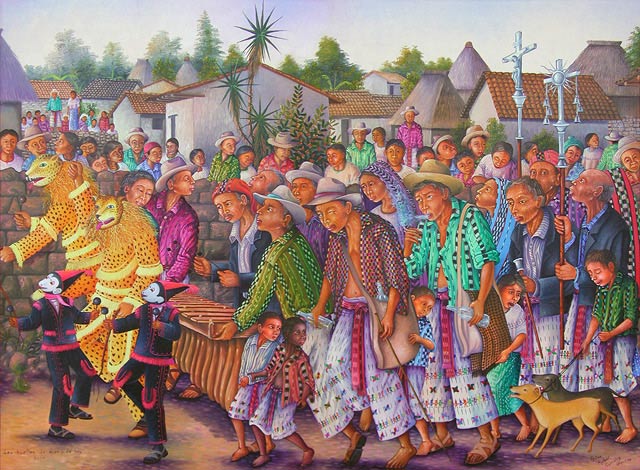 |
| Pedro Rafael González Chavajay Las Huellas de Ayer y de Hoy The Footsteps of Yesterday and Today Middle Panel 2001 30" x 40" |
| Under the cofradía system men would alternate
their public service, which was for a year at a time, between the church
and the municipal government of the town. During the year of service
their responsibilities to their work and family would be handled by
other family members so they could devote themselves to the needs of the
government or the church. As a person got older, they were given
positions of greater importance. The alcalde [mayor] would be
chosen by the towns’ elders—men of the village who were present or
past heads of the seven different cofradías. This system where
the alcalde was chosen by people who had served in the religious cofradías
kept the government of the town and the church intertwined. The alcalde
in the painting is the man to the right of the panel with the black
jacket and between the two crosses of the church. His position between
the crosses exemplifies the interconnectedness between the church and
the municipal government which existed at this time. The cofradía
system ended in the 1970s in San Pedro.
Tradition dictated that part of the ritual of these festivals was participating in drinking. Because a person might participate several times a day in a ceremony which obligated drinking, a person—like a couple of men in this panel—could easily end up drinking too much. In large part due to excesses of drinking (and the accompanying alcoholism) which always occurred at these festivals about half of the people in San Pedro became fundamentalist Christians who disapprove of any drinking The mayor is now elected by the people at large at the same time as the national elections. His selection is no longer the exclusive privilege of all male elders of the town. With elections being overseen by the national government with its multitude of political parties, the municipal government of San Pedro and all the Maya towns are now independent of the cofradia system and the Catholic Church. The national government is western rather than Maya in nature. The municipal government although it retains aspects of the cofradía system such as aguaciles, no longer necessarily works to preserve the Maya traditions and costumbres just as it doesn’t work to preserve the Catholic Church. The municipal government, like this panel, is now separate from the Catholic Church and the Maya traditions.
|